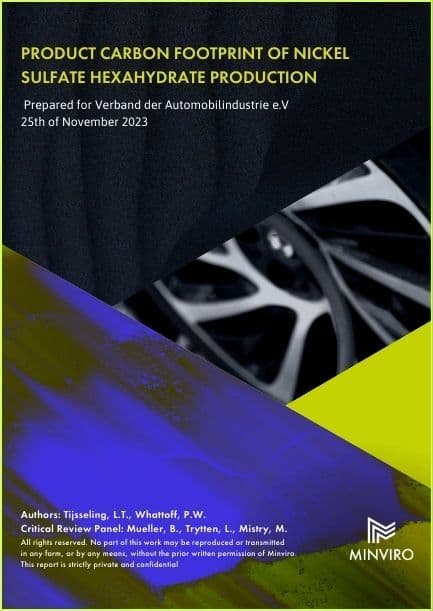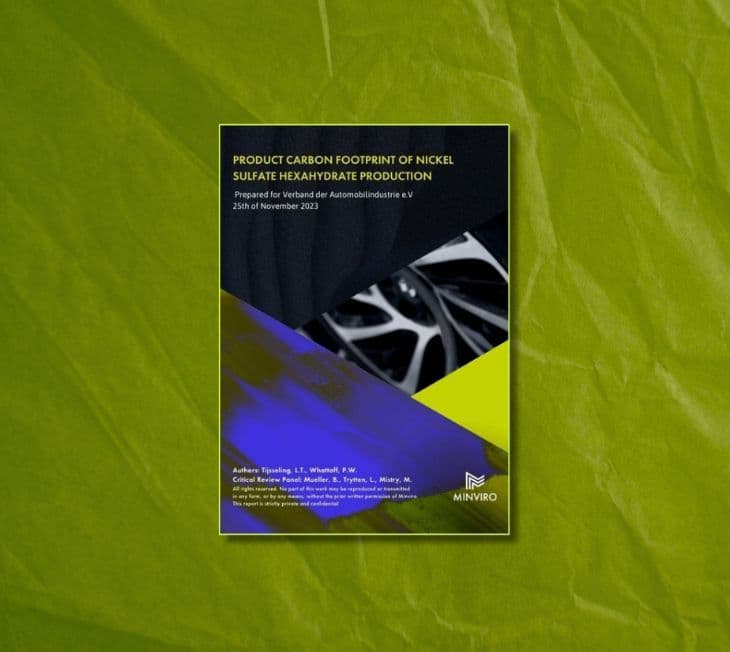- solutions
- industries
- about us
- resources
Consultancy
VDA Project Results: LCA of Nickel Sulfate Hexahydrate Impact
By Laurens Tijsseling, Phoebe Whattoff
In collaboration with the German Association of the Automotive Industry (VDA), Minviro has developed a detailed report on the climate change impact of three existing and emerging nickel sulfate hexahydrate production pathways. With the upcoming European battery regulations, it will be essential to have primary or representative secondary data. This LCA study, which went through a critical panel review, aims to provide insights into what the range of climate change impacts can be for different production pathways, and to provide context to the main drivers of these differences.
Download
The outline
Study Overview
The pathways covered in the study are from Canadian sulfide ore via pyrometallurgy, Indonesian laterite ore via high pressure acid leaching (HPAL, and Indonesian laterite ore processed into nickel pig iron (NPI) and nickel matte using pyrometallurgy. The functional unit is one kilogram of nickel in nickel sulfate hexahydrate. This is a cradle to gate study. The impacts are measured from initial ore extraction, up to a defined end gate. The end gate has been set at nickel sulfate hexahydrate ready for shipment at the final processing facility.
This report focus on Climate Change Impact Variation of the Nickel Sulfate Hexahydrate Production Pathways.
Production & Comparison Study
For each of the three identified routes, the relative impact of mining, upgrading, chemical processing and transport of intermediates has been quantified, and for each of those stages the specific drivers of climate change impact have been quantified. This showed that for the assumptions in the study Canadian nickel sulfide ore has the lowest climate change impact, followed by fossil fuel powered HPAL processing of laterite ore in Indonesia, and with production of nickel matte via RKEF having the highest climate change impact.
Climate Change Value Proposition
Compared to both Indonesian routes, the Canadian production pathway benefits from access to renewable electricity compared to fossil energy in Indonesia and from the presence of copper, cobalt, platinum, palladium and gold in the ore which is accounted for using a combination of mass based and economic allocation. To explore the sensitivity of the comparison to the co-product and fossil energy assumption, scenarios were explored where the Canadian ore would have no co-product, and a scenario where all energy requirements for the Indonesian HPAL plant can be sourced from a sulfuric acid plant on site. This showed that if the Canadian route has no co-product, and the Indonesian HPAL facility does not use fossil fuels, the climate change impact of nickel sulfate hexahydrate of nickel sulfide and nickel laterite ore can be of the same order of magnitude. This is especially important considering that Indonesia is emerging itself as a nickel powerhouse, whilst supply of nickel from Canada is limited at the time of writing.
The Value of the LCA
This study has enabled VDA, its members and now the public to understand the GHG sensitivities of three potential production pathways, which after external validation by the critical panel review, can be used to communicate comparative assertions to the public. Additionally, any nickel end user now can use the results for decarbonisation planning to understand what can be done to chase out GHG’s in their nickel supply chains.
download
Get access today
Fill in the form below
Download
